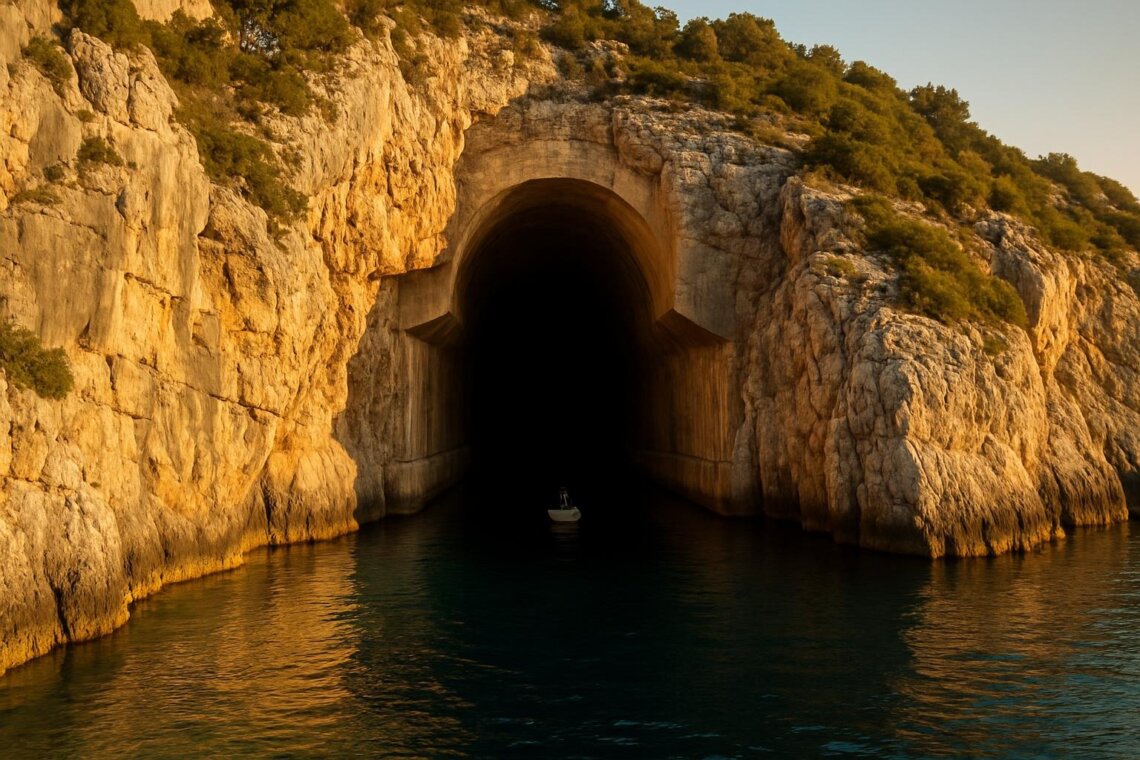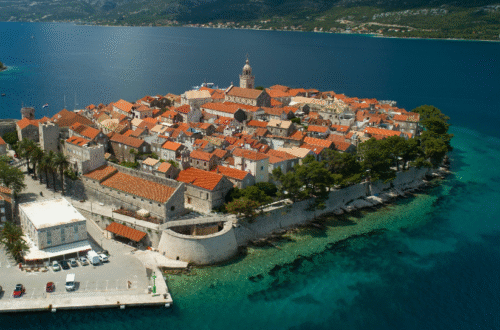
Vis Military Tunnels: Exploring the Hidden Underground Secrets of Croatia’s Island Fortress
Vis Military Tunnels: Exploring the Hidden Underground Secrets of Croatia’s Island Fortress
Deep beneath the crystalline waters and sun-drenched vineyards of Croatia’s Vis Island lies one of Europe’s most intriguing Cold War secrets. Formerly Yugoslavia’s “forbidden island,” this sleepy little city still holds the abandoned remains of military strongholds that once housed submarines, missiles, and thousands of Yugoslav soldiers. Today, these Vis military tunnels have transformed from classified installations into one of Croatia’s most captivating tourist attractions, offering visitors a rare glimpse into a hidden world carved directly from limestone cliffs.
This comprehensive guide will take you through the labyrinthine network of underground passages that stretch across Vis Island, from the massive submarine pens that once sheltered 110-meter vessels to the command centers where military operations were coordinated. Whether you’re a history enthusiast, adventure seeker, or simply curious about one of Europe’s best-preserved Cold War relics, the military tunnels of Vis offer an unforgettable journey into Croatia’s strategic past.
The Strategic Importance of Vis Island
Positioned 40 kilometers from the Croatian mainland in the heart of the Adriatic Sea, Vis is probably strategically the most important island in Adriatic Sea. This remote location, far from major shipping lanes yet perfectly positioned to monitor maritime traffic between Italy and the Balkans, made it an invaluable military asset for successive powers throughout history.
During World War II, Vis gained international significance as a crucial Allied base in the Mediterranean theater. Early in July 1944, the novelist Evelyn Waugh flew with Randolph Churchill from Bari, Italy, to Vis as part of the British military mission to Yugoslavia. There they met Marshal Tito. The island served as a vital launching point for operations against Axis forces and became a refuge for Yugoslav Partisans.
The island’s military importance only intensified after the war. After the war, the Yugoslav People’s Army used the island as one of its main naval bases, transforming it into an impregnable fortress in the Adriatic. During socialist Yugoslavia, Vis was home to more than 30 military facilities and was closed to foreigners until 1989, earning it the nickname “Yugoslavia’s forbidden island.”

Origins of the Military Tunnels on Vis
The extraordinary network of Vis military tunnels represents one of the most ambitious underground construction projects of the Cold War era. While some installations date back to World War II, the massive expansion occurred during the 1960s and 1970s under President Josip Broz Tito’s military modernization program.
Construction of the tunnel network was a herculean task that lasted over 15 years. Standing at the entrance, you’re looking at 15 years of construction work, with Yugoslav military engineers carving directly into the island’s limestone cliffs. The project employed thousands of workers, including local residents who were sworn to secrecy about the installations’ true purpose and scope.
The tunnels served multiple critical military functions:
- Submarine shelters: Protecting naval vessels from aerial surveillance and attack
- Weapons storage: Secure underground arsenals for ammunition and military equipment
- Command centers: Underground headquarters for coordinating naval operations
- Personnel quarters: Living facilities for military staff stationed on the island
- Communication hubs: Protected sites for radio and radar equipment
The military base on Vis is a network of several subsurface tunnels, caves and facilities in total around 20km, making it one of Europe’s most extensive underground military installations. The sheer scale of this project demonstrates the strategic importance Yugoslavia placed on maintaining control over Adriatic sea lanes during the Cold War.
Exploring the Submarine Pen at Parja Bay
The crown jewel of Vis’s military installations is undoubtedly the massive submarine tunnel, known locally as the “Jastog” (Lobster) tunnel, located in Parja Bay near Vis town. This engineering marvel represents the pinnacle of Cold War military construction and remains the most visited attraction for tourists exploring the island’s hidden military heritage.
Invisible from the air and well-disguised by the surrounding rocky coastline, this 127-metre long and 18-metre high tunnel was designed to shelter a 110-metre submarine. The tunnel’s dimensions are truly staggering – carved directly from solid limestone, it could accommodate the largest submarines in the Yugoslav Navy while keeping them completely hidden from enemy reconnaissance.
Big enough to shelter submarines up to 110 metres long, this secret submarine base located in Parja Bay near Vis town, was part of a wider network of military tunnels and caves across the island. The entrance opens directly onto the Adriatic Sea, allowing submarines to enter and exit under the cover of darkness while remaining completely concealed during daylight hours.
What makes the Jastog tunnel particularly fascinating is its remarkable preservation. Unlike many abandoned military installations across Eastern Europe, the submarine pen remains largely intact, with its original infrastructure still visible. These days visitors can go inside with small boats or even swim in the pen itself, offering an incredibly unique experience of exploring a genuine Cold War submarine base.

The Network of Underground Tunnels and Bunkers
Beyond the famous submarine pen, Vis Island conceals an intricate web of underground installations that once formed the backbone of Yugoslavia’s Adriatic defense strategy. These tunnels and bunkers, scattered across strategic locations throughout the island, created an virtually impregnable military fortress.
Mount Hum: The highest peak on Vis (587 meters) houses extensive radar installations and command bunkers that provided surveillance over hundreds of kilometers of Adriatic waters. The mountain’s summit contains a complex network of underground facilities connected by reinforced tunnels, many of which remain off-limits to tourists due to safety concerns.
Stupište Missile Base: Near the town of Komiža, this sophisticated installation contained surface-to-air missile batteries protected by underground command tunnels. The base could coordinate defensive operations across the entire central Adriatic region.
Samogor Military Complex: The largest military base on the island, Samogor contained extensive underground storage facilities, personnel quarters, and command centers. This sprawling complex demonstrates the scale of Yugoslavia’s commitment to defending Vis.
The tunnel network’s construction required innovative engineering solutions. The main tunnel system is carved directly into limestone cliffs, taking advantage of the island’s geological composition to create naturally reinforced underground spaces. Many tunnels extend several kilometers into the island’s interior, connecting different military installations through a web of underground passages.
Armed forces could hide in case of an invasion, with the tunnel network designed to sustain a prolonged siege. The installations included underground water sources, ventilation systems, and storage areas capable of supporting thousands of personnel for extended periods.
Life Inside the Tunnels During the Cold War
The daily reality for soldiers stationed within Vis’s underground installations was both fascinating and challenging. These tunnels weren’t merely storage facilities or defensive positions – they were complete underground communities where military personnel lived, worked, and prepared for potential conflicts throughout the Cold War era.
The underground facilities contained surprisingly sophisticated infrastructure for their time. Living quarters carved from limestone housed dozens of soldiers, with separate areas for officers and enlisted personnel. Underground kitchens prepared meals for entire battalions, while communication rooms maintained contact with military headquarters on the Yugoslav mainland.
Working conditions inside the tunnels were demanding. The constant dampness from the Adriatic’s proximity, combined with limited natural light, created a unique environment that required mental resilience from stationed personnel. Soldiers adapted to life in these underground spaces, developing routines that maximized the limited recreational facilities available within the installations.
Our guide Petar’s father worked on the tunnels, providing personal connections to the construction era that many tour guides can share with visitors. These first-hand accounts from families who lived through Vis’s military period add authenticity and human interest to the historical narrative.
The psychological impact of prolonged underground service was significant. Military personnel developed strong camaraderie bonds while serving in these isolated installations, creating lasting friendships forged in the unique environment of Yugoslavia’s secret island fortress.
From Military Secret to Tourist Attraction
The transformation of Vis’s military tunnels from classified installations to popular tourist attractions represents one of Croatia’s most successful heritage tourism developments. This remarkable transition began in the early 1990s following Yugoslavia’s dissolution and continues evolving today.
After the independence of Croatia, the Yugoslav Army left the island on May 30, 1992, ending decades of military occupation that had defined island life. The sudden departure left behind a vast network of abandoned installations, creating both opportunities and challenges for the local community.
Initially, many tunnels fell into disrepair as nature began reclaiming these man-made spaces. However, enterprising locals recognized the tourism potential of these unique historical sites. Many of the tunnels have already been adapted for civilian uses, with some converted into wine cellars, demonstrating creative repurposing of military infrastructure.
The development of organized military tours began in the early 2000s as Croatia’s tourism industry expanded. Local operators invested in safety equipment, lighting systems, and transportation to make these historically significant sites accessible to international visitors. Today, the tunnels represent a major economic opportunity for Vis Island, attracting thousands of history enthusiasts annually.
Conservation efforts focus on preserving the tunnels’ historical integrity while ensuring visitor safety. Many installations require ongoing maintenance to prevent structural deterioration, particularly those exposed to saltwater infiltration from the adjacent Adriatic Sea.
Guided Tours of Vis Military Tunnels
Exploring Vis’s military tunnels independently is neither safe nor legal, making guided tours the only way to experience these remarkable historical sites. Several local operators offer comprehensive military tours that provide access to otherwise restricted installations while ensuring visitor safety and historical context.
Jeep Safari Tours: The most popular option combines off-road adventure with historical exploration. Our tour focuses on 2nd WW and we have selected the most fascinating locations, an optimum to explore in 4 hours: tunnels, guns, atomic shelter for 200 people, ex-airport, underground torpedo and ammunition storage spots, 100 m submarine tunnel, Vis highest peak and radar station. These comprehensive tours typically cost between €40-60 per person and include transportation, guide services, and entry to multiple military sites.
Boat Tours: The Vis Military Tour takes you to hidden tunnels, missile bases, and Tito’s Cave – an unforgettable guided experience accessible from the water. These marine-focused tours provide unique perspectives of the submarine tunnels and coastal installations, often including swimming opportunities in the submarine pen itself.
Private Tours: PRIVATE MILITARY TOUR from 320 € PER JEEP, meaning personalised tour, the route, timing, locations – all flexible. These premium options allow customized itineraries focusing on specific interests, whether WWII history, Cold War installations, or engineering marvels.
Tour duration typically ranges from 3-5 hours, with most operators providing multiple daily departures during peak season (May-October). Advanced booking is recommended, particularly for private tours or visits during summer months when demand peaks.

Practical Travel Tips for Visiting
Successfully exploring Vis’s military tunnels requires proper preparation and awareness of the unique challenges these historical sites present. Understanding what to expect and how to prepare will maximize your experience while ensuring safety throughout your underground adventure.
Essential Equipment:
- Reliable flashlight: Many tunnel sections have limited or no artificial lighting
- Sturdy footwear: Non-slip shoes are crucial for navigating wet, uneven limestone surfaces
- Waterproof clothing: Tunnels can be damp, and some tours include water activities
- Camera with flash: Standard phone cameras often struggle in low-light tunnel conditions
Safety Considerations: The underground environment presents unique challenges that visitors should understand before participating in military tours. Tunnel floors can be slippery from moisture, and ceiling heights vary dramatically throughout different installations. Some passages require crawling or crouching, making claustrophobic visitors uncomfortable.
Temperature inside the tunnels remains constant year-round (around 15-18°C), significantly cooler than surface temperatures during summer months. Bringing a light jacket or sweater is advisable even during hot weather.
Accessibility Notes: Unfortunately, most military tunnels are not wheelchair accessible due to their original military construction specifications. Uneven surfaces, narrow passages, and steep inclines make navigation challenging for visitors with mobility limitations. However, some tour operators offer modified experiences focusing on more accessible installations.
Best Visiting Times: Peak tourist season (July-August) brings crowded conditions and higher prices. Shoulder seasons (May-June, September-October) offer optimal weather conditions with fewer crowds and more personalized tour experiences. Winter visits are possible but weather-dependent for boat-based tours.
Other Military Sites on Vis Island
While the submarine tunnels capture most attention, Vis Island contains numerous other military installations that provide comprehensive insights into the island’s strategic importance throughout the 20th century.
Fort George: This 19th-century British fortress, later adapted by Yugoslav forces, represents the island’s earlier military significance. Built during the Napoleonic Wars to control Adriatic shipping lanes, the fort offers spectacular views over Vis harbor while showcasing military architecture spanning multiple historical periods.
Mount Hum Radar Station: The summit installation contains Cold War-era radar equipment and observation posts that monitored air and sea traffic across the central Adriatic. The facility’s elevated position provided early warning capabilities for the entire Yugoslav coastal defense network.
Abandoned Airstrip: World War II runways remain visible near Vis town, where Allied forces operated fighter aircraft supporting operations throughout the Mediterranean theater. During WWII the island was also home to 1435 Squadron of the RAF flying Mark IX Spitfires in ground support of allied troops fighting in Italy.
Coastal Artillery Positions: Scattered around the island’s perimeter, these installations housed large-caliber guns capable of engaging naval targets at significant distances. Many positions remain equipped with original artillery pieces, providing tangible connections to the island’s defensive capabilities.
The tours take in everything from rocket shelters and bunkers to weapon-storage halls and “parking lots” (read: tunnels) for submarines, demonstrating the comprehensive military infrastructure that once dominated island life.
Why Visit the Military Tunnels of Vis?
The military tunnels of Vis offer a unique combination of historical significance, adventure tourism, and educational value that few destinations worldwide can match. This underground world provides tangible connections to Cold War history while showcasing remarkable engineering achievements accomplished under challenging circumstances.
Historical Authenticity: Unlike many military museums that display replicas or reconstructed installations, Vis’s tunnels preserve original Cold War infrastructure in remarkable condition. Visitors experience genuine military installations exactly as they were used during Yugoslavia’s most tense international periods.
Adventure Tourism: The underground exploration experience appeals to adventure seekers looking for alternatives to traditional sightseeing. Navigating tunnel networks, swimming in submarine pens, and accessing restricted military sites creates memorable experiences unavailable elsewhere in Croatia.
Educational Value: The installations provide comprehensive insights into Cold War military strategy, engineering challenges, and daily life within Yugoslavia’s defense establishment. Professional guides offer historical context that transforms underground exploration into meaningful learning experiences.
Photography Opportunities: The dramatic contrast between limestone tunnels and Adriatic waters creates stunning visual compositions for photographers. The interplay of natural and artificial lighting within tunnel systems offers unique creative possibilities.
Exclusive Access: Many installations remain restricted outside organized tours, making guided visits the only opportunity to experience these historical sites. This exclusivity adds value for travelers seeking unique experiences beyond typical tourist attractions.

Conclusion: Step Into History Beneath the Surface of Vis
The military tunnels of Vis Island represent one of Europe’s most fascinating and well-preserved Cold War relics, offering visitors an extraordinary journey into a hidden world carved from limestone cliffs above the Adriatic Sea. From the massive submarine pen that once sheltered 110-meter naval vessels to the extensive network of command centers and storage facilities, these installations provide unparalleled insights into Yugoslavia’s military strategy during one of history’s most tense international periods.
Secret army tunnels carved into the remote Croatian island of Vis by the Yugoslav army have become a draw for tourists and locals alike since opening to the public, transforming from classified military installations into one of Croatia’s most unique tourist attractions. The preservation of these historical sites creates opportunities for future generations to understand the complex geopolitical forces that shaped Cold War Europe.
Whether you’re fascinated by military history, seeking adventure tourism experiences, or simply curious about hidden aspects of Croatian heritage, the tunnels of Vis deliver unforgettable experiences. Professional guided tours provide safe access to otherwise restricted installations while offering expert historical context that brings these underground spaces to life.
Planning your visit to Vis Island’s military tunnels means preparing for an adventure that combines physical exploration with historical education. As you navigate the same passages once used by Yugoslav submarines and walk through command centers that coordinated Adriatic defense operations, you’ll gain unique appreciation for the strategic importance of this remote island fortress.
The next time you’re planning a Croatian adventure, consider venturing beyond the typical coastal destinations to discover the hidden military heritage of Vis Island. Step into history beneath the surface and explore the underground secrets that once protected Yugoslavia’s Adriatic frontier – an experience that truly embodies the intersection of natural beauty and human ingenuity that defines Croatia’s most compelling historical attractions.




